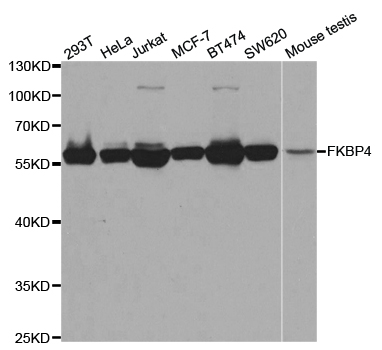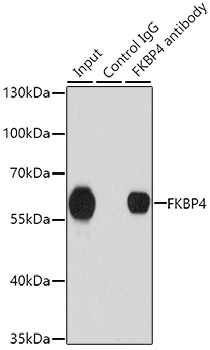FKBP4 antibody
GTX113437
ApplicationsImmunoFluorescence, Western Blot, ImmunoCytoChemistry
Product group Antibodies
ReactivityHuman, Mouse, Rat
TargetFKBP4
Overview
- SupplierGeneTex
- Product NameFKBP4 antibody
- Delivery Days Customer9
- Application Supplier NoteWB: 1:500-1:3000. ICC/IF: 1:100-1:1000. *Optimal dilutions/concentrations should be determined by the researcher.Not tested in other applications.
- ApplicationsImmunoFluorescence, Western Blot, ImmunoCytoChemistry
- CertificationResearch Use Only
- ClonalityPolyclonal
- Concentration0.99 mg/ml
- ConjugateUnconjugated
- Gene ID2288
- Target nameFKBP4
- Target descriptionFKBP prolyl isomerase 4
- Target synonymsFKBP51, FKBP52, FKBP59, HBI, Hsp56, PPIase, p52, peptidyl-prolyl cis-trans isomerase FKBP4, FK506 binding protein 4, 59kDa, HSP binding immunophilin, T-cell FK506-binding protein, 59kD, peptidylprolyl cis-trans isomerase, rotamase
- HostRabbit
- IsotypeIgG
- Protein IDQ02790
- Protein NamePeptidyl-prolyl cis-trans isomerase FKBP4
- Scientific DescriptionThe protein encoded by this gene is a member of the immunophilin protein family, which play a role in immunoregulation and basic cellular processes involving protein folding and trafficking. This encoded protein is a cis-trans prolyl isomerase that binds to the immunosuppressants FK506 and rapamycin. It has high structural and functional similarity to FK506-binding protein 1A (FKBP1A), but unlike FKBP1A, this protein does not have immunosuppressant activity when complexed with FK506. It interacts with interferon regulatory factor-4 and plays an important role in immunoregulatory gene expression in B and T lymphocytes. This encoded protein is known to associate with phytanoyl-CoA alpha-hydroxylase. It can also associate with two heat shock proteins (hsp90 and hsp70) and thus may play a role in the intracellular trafficking of hetero-oligomeric forms of the steroid hormone receptors. This protein correlates strongly with adeno-associated virus type 2 vectors (AAV) resulting in a significant increase in AAV-mediated transgene expression in human cell lines. Thus this encoded protein is thought to have important implications for the optimal use of AAV vectors in human gene therapy. The human genome contains several non-transcribed pseudogenes similar to this gene. [provided by RefSeq]
- ReactivityHuman, Mouse, Rat
- Storage Instruction-20°C or -80°C,2°C to 8°C
- UNSPSC12352203
References
- Chang JF, Lin ST, Hung E, et al. Nuclear proteomics with XRCC3 knockdown to reveal the development of doxorubicin-resistant uterine cancer. Toxicol Sci. 2014,139(2):396-406. doi: 10.1093/toxsci/kfu051Read this paper






